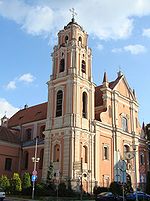
All Saints Church, Vilnius
Encyclopedia

Baroque
The Baroque is a period and the style that used exaggerated motion and clear, easily interpreted detail to produce drama, tension, exuberance, and grandeur in sculpture, painting, literature, dance, and music...
style church in Vilnius
Vilnius
Vilnius is the capital of Lithuania, and its largest city, with a population of 560,190 as of 2010. It is the seat of the Vilnius city municipality and of the Vilnius district municipality. It is also the capital of Vilnius County...
, Lithuania
Lithuania
Lithuania , officially the Republic of Lithuania is a country in Northern Europe, the biggest of the three Baltic states. It is situated along the southeastern shore of the Baltic Sea, whereby to the west lie Sweden and Denmark...
. All Saints church was built between 1620-1630 and was adopted for Carmelites
Carmelites
The Order of the Brothers of Our Lady of Mount Carmel or Carmelites is a Catholic religious order perhaps founded in the 12th century on Mount Carmel, hence its name. However, historical records about its origin remain uncertain...
' needs. In the second half of the 17th century, the church was linked with a monastery
Monastery
Monastery denotes the building, or complex of buildings, that houses a room reserved for prayer as well as the domestic quarters and workplace of monastics, whether monks or nuns, and whether living in community or alone .Monasteries may vary greatly in size – a small dwelling accommodating only...
and formed a single complex. The bell tower is high and massive with elaborate decorations. After a fire in the 18th century, it was restored and finished with a rococo
Rococo
Rococo , also referred to as "Late Baroque", is an 18th-century style which developed as Baroque artists gave up their symmetry and became increasingly ornate, florid, and playful...
-style dome roof. A large old rule Carmelite friary, constructed using the existing buildings is located near the church. Marcin Knackfus
Marcin Knackfus
Marcin Knackfus was a Polish–Lithuanian Neoclassical architect of German descent. Born near Warsaw, he worked in the Grand Duchy of Lithuania and particularly in its capital Vilnius...
prepared project for the church's altar.
The Church of all Saints is at the end of Szpitalna St., where the main gate to the Jewish ghetto
Vilna Ghetto
The Vilna Ghetto or Vilnius Ghetto was a Jewish ghetto established by Nazi Germany in the city of Vilnius in the occupied Lithuanian Soviet Socialist Republic , during the Holocaust in World War II...
was. During World War II
World War II
World War II, or the Second World War , was a global conflict lasting from 1939 to 1945, involving most of the world's nations—including all of the great powers—eventually forming two opposing military alliances: the Allies and the Axis...
, there was a tunnel through the sewers connecting the church with the ghetto. The priest of the church would provide bread to be taken into the ghetto through the tunnel. He also hid some Jews smuggled out of the ghetto through the tunnel. It should also be noted that there were Christian Lithuanians who helped smuggle Litvaks
Lithuanian Jews
Lithuanian Jews or Litvaks are Jews with roots in the Grand Duchy of Lithuania:...
food into the ghetto.
Between 1967 and 1975 the church underwent reconstruction and was used for museum expositions. During these Soviet times, the church housed a folk art museum but has now been returned to the faithful.

